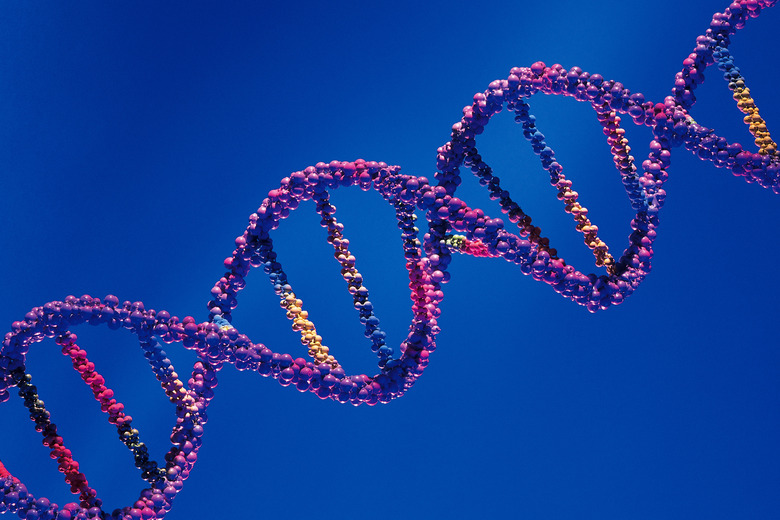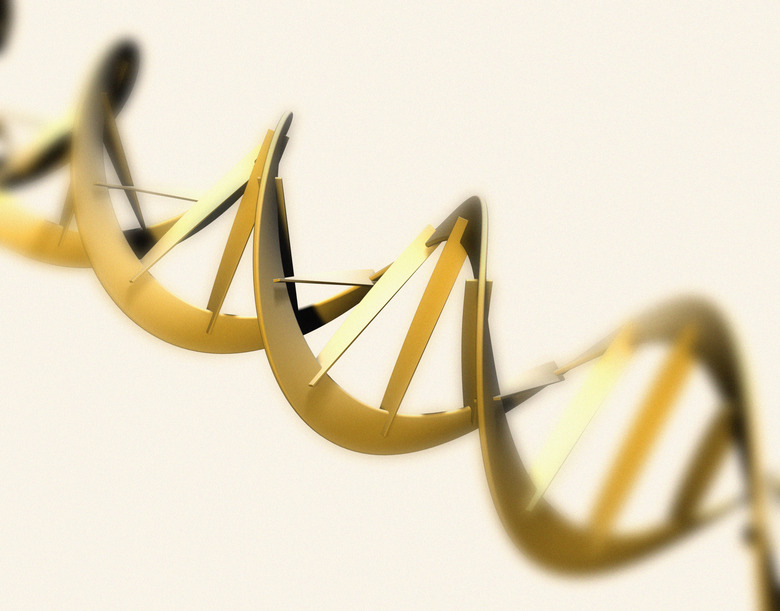What Are Some Characteristics Of DNA?
DNA, or deoxyribonucleic acid, is widely known as the fundamental building block of life. These molecules contain a genetic code that dictates cellular activity and biological development in nearly all living organisms. DNA is passed down from parents and inherited by offspring. It dictates specific traits including what an individual will look like to how long it is likely to live. The complete human genome is made up of about three billion DNA molecules.
DNA From Parents
DNA From Parents
Human beings get one complete set of genes from their mother and another from their father. Genes are sequences of nucleotides that hold information to build and maintain cells. Genes can dictate an individual's skin color, body type, personality and even IQ. In total, humans have about 30,000 different genes spread between 46 chromosomes. Each chromosome contains slightly fewer than 1,000 genes.
Chromosomes
Chromosomes
DNA is coiled up into chromosomes in the nucleus of a cell. Aside from reproductive cells, every cell contains 46 linear chromosomes. Of the 23 pairs of chromosomes (46 total), 22 are similar in size, shape and genetic content. These chromosomes are known as autosomes. The 23rd pair is known as a sex chromosome. It is made up of either two X chromosomes or an XY chromosome combination and determines the sex of an individual. Cells with two X chromosomes yield females and cells with one X and one Y chromosome yield males.
DNA Bases
DNA Bases
Four chemical bases make up DNA coding: adenine (A), guanine (G), cytosine (C) and thymine (T). Base pairs are created when bases A and T pair up and bases C and G pair up. These base pairs link to a phosphate molecule and a sugar molecule, creating a larger structure known as a nucleotide. Nucleotides are arranged into spiral formations called double helixes. The double helix is built similarly to a ladder – the rungs are made of base pairs (either A&T combinations or C&G combinations) and the side pieces are made of sugar and phosphate molecules.
Replication
Replication
DNA replication is critical to new cells. All new cells must have an exact copy of the DNA that was present in originating cells. A copy of the hereditary "blueprint" is important because it directs cellular activity and overall biological development. Fortunately, each strand of the double helix can serve as a pattern for duplication.
Uniqueness
Uniqueness
DNA sequencing is unique in humans. Aside from rare cases of identical twins, no two people will share the same exact DNA. However, of the roughly three billion base pairs that complete the human genome, more than 99 percent are the same in all people. The closest living relative to humans, the chimpanzee, shares 96 percent of our DNA. Despite a seemingly high comparison rate, humans and chimpanzees still have 40 million different DNA molecules.
Cite This Article
MLA
Belhumeur, Kevin. "What Are Some Characteristics Of DNA?" sciencing.com, https://www.sciencing.com/what-are-some-characteristics-of-dna-12572069/. 25 October 2017.
APA
Belhumeur, Kevin. (2017, October 25). What Are Some Characteristics Of DNA?. sciencing.com. Retrieved from https://www.sciencing.com/what-are-some-characteristics-of-dna-12572069/
Chicago
Belhumeur, Kevin. What Are Some Characteristics Of DNA? last modified August 30, 2022. https://www.sciencing.com/what-are-some-characteristics-of-dna-12572069/

